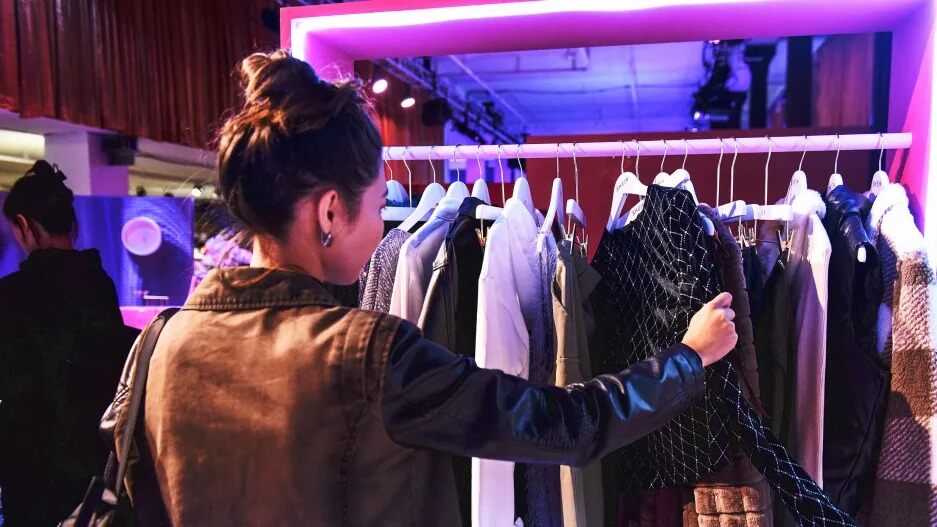- | 12:00 pm
Inside Gen Z’s conflicting passions for both sustainability and shopping
And how brands can help break the disastrous cycle.

The culture of unconscious consumption may finally be shifting. Conversations around sustainability have become mainstream, forcing retailers across categories to rethink their approaches to sustainability. The recent GlobeScan Healthy & Sustainable Living report finds there is strong interest in sustainable shopping, particularly among Gen Z consumers. When compared to baby boomers plus, Gen Z in the U.S. is significantly more interested in buying products secondhand (71% versus 34%), bringing their own reusable containers to the store (71% versus 36%), avoiding disposable items (67% versus 40%), and choosing products made from recycled materials (72% versus 46%).
So then, why do these climate-conscious shoppers often fail to follow through at the point of sale?
Gen Z’s climate anxiety and aspiration for sustainable living is at odds with their love of shopping. Of those surveyed, 58% of Gen Zers in the U.S. ”strongly” and “somewhat” agree that they need a lot of material possessions to be happy. They remain loyal to fast-fashion like Shein and mass retailers like Walmart and Amazon, where they can get more for their money. So it’s no wonder members of this demographic are also seven times more likely to ”strongly” agree that they “feel guilty about my negative impact on the environment” compared to baby boomers plus.
Retailers that innovate to reconcile Gen Z’s love of shopping with their climate guilt stand to win the love and loyalty of an emerging generation of eco-conscious shoppers. This will require giving consumers more value and impact for their money by rethinking business models, materials, and marketing so that shopping sustainably doesn’t feel like a compromise.
There are three emerging imperatives for how brands can meet this challenge head-on:
MAKE SUSTAINABLE LIVING ACCESSIBLE
For all of Gen Z’s good eco-intentions, cost-consciousness is a factor that cannot be ignored. COVID-19 safety nets have evaporated, inflation woes remain persistent, and our research also confirms that across product categories—from electronics to cleaning products—consumers overwhelmingly view sustainable products as being more expensive than regular products, regardless of whether or not they actually are.
The confluence of climate and economic anxiety adds up to a potentially dramatic significant shift in consumption patterns. People say they want to shop for sustainable products, but when it comes down to affordability, they might opt for cheaper, less-sustainable options. And this conflict is particularly true for young people who crave novelty and also lack the income stability to save up for more durable, sustainably made goods. Young consumers appear to be faced with the dilemma of either saving the planet or saving their money. However, we believe this is a false choice.
Retail models like renting and buying secondhand that were previously seen as merely for the thrifty are gaining new status as a bastion for eco-conscious shoppers. The secondhand apparel market is set to reach $350 billion globally by 2027, and the North American refurbished electronics market is expected to reach roughly $32 billion by 2027.
The big opportunity for brands in the circular economy is to adopt secondhand models that attract more consumers, drive sales, and deliver on brand loyalty. For example, a new generation of companies like Back Market, Recurate, and threadUP make it possible for brands like Steve Madden and J.Crew to build secondhand capabilities and seamless back-end operations that are customizable so that they own the brand experience and inspire more engagement. By making circular goods readily available and accessibly priced, we believe these brands can help consumers not only embrace secondhand, but also reduce purchases of new products, breaking up with fast-fashion and disposable goods.
STRIVE FOR NET POSITIVE IMPACT
It’s no longer enough for brands to just do “less harm.” They need to give more than they take if they want to endure in a rapidly changing society and ensure that we make up lost ground in today’s climate and equality crises. While it’s true that we’re not going to shop our way out of the problems, the brands that acknowledge their role in an interconnected ecosystem and address the harms their businesses helped create—by effecting true systemic change, not just token support or donations—are the brands that will earn the love of the next generation.
Our study backs this up by showing that two out of three Gen Z consumers globally agree companies should support the UN’s Sustainable Development Goals. Brands that are deeply aware of the needs of their customers, employees, and communities will begin to find those connection points where they can address social and environmental issues.
Ikea, for example, is aware of the increasing housing instability among low-income renters and has invested in assistance to unhoused populations as well as trained its staff members to help renters understand their housing rights. Crocs rose to popularity with Gen Z by being a champion of self-expression, comfort, and cutting carbon. To invite more equity and climate-consciousness into online shopping, the new Clean Beauty at Walmart helps shoppers find affordable beauty products that align with their values, while Google has added filters for Black-owned, women-owned, and Latino-owned businesses along with a #BlackOwnedFriday campaign featuring Ludacris and Flo Milli. And The North Face Renewed, a line of refurbished apparel from the outdoor brand, promotes its durability alongside its sustainability, offering access to more adventure at a lower price point. The beauty of these examples is that they don’t ask shoppers to do anything extra to save the planet; they simply offer them something of value that also makes a positive impact in society.
DESIGN AWAY THE BROKEN STATUS QUO
Our current consumer economy that takes from the environment and creates waste is no longer serving us. For consumers feeling angst from all of the packaging, expired goods, and broken wares that end up in the trash, many retailers are focusing on how to design “waste” out of the equation so that everyday purchases come with less environmental impact.
This has led to new retail experiences like Target Zero, a curated collection of products that are refillable, compostable, recyclable, and help eliminate plastic waste in packaging. There’s also a new class of e-commerce brands like Grove and Blueland that offer elegant, refillable alternatives to disposable household-cleaning and personal-care products.
Materials science is also unlocking new possibilities for products that meet consumer needs, look cool, and do no harm. Sneaker culture is leading this wave with materials that are recyclable, plant-based, and made from byproducts that would otherwise end up in landfills. The Swiss company On has even developed a running shoe designed to be “shredded, melted, and turned into new pairs” as part of a subscription model that enables endless access to new shoes with zero waste. Meanwhile, electronics brands like Nokia are starting to take small steps to address the lack of a nationwide right-to-repair law and battle e-waste by designing devices that are easier to fix.
These are exciting signals of what a sustainable future for consumer goods and retail can look like. But there’s a long way to go, and we won’t get there fast enough without more brands participating and consumers changing their consumption behavior. It’s crucial that brands continue to increase their efforts, giving young consumers a much greater range of sustainable options. Doing that will require respecting Gen Z’s dueling desires for sustainability and affordability, and make it easier and more fun to support brands that meet both of those aspirations.








































